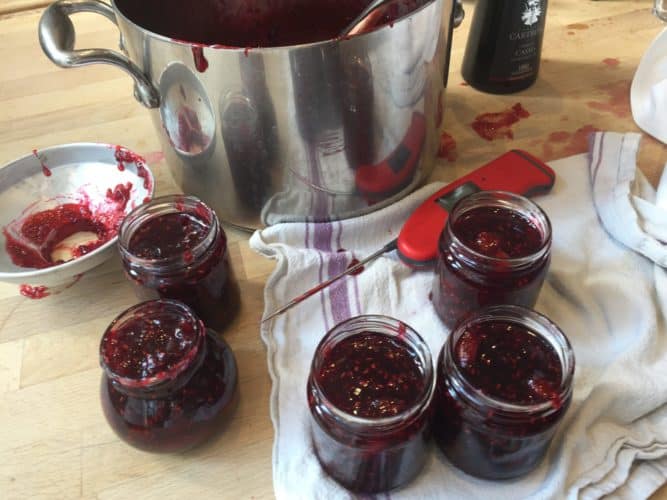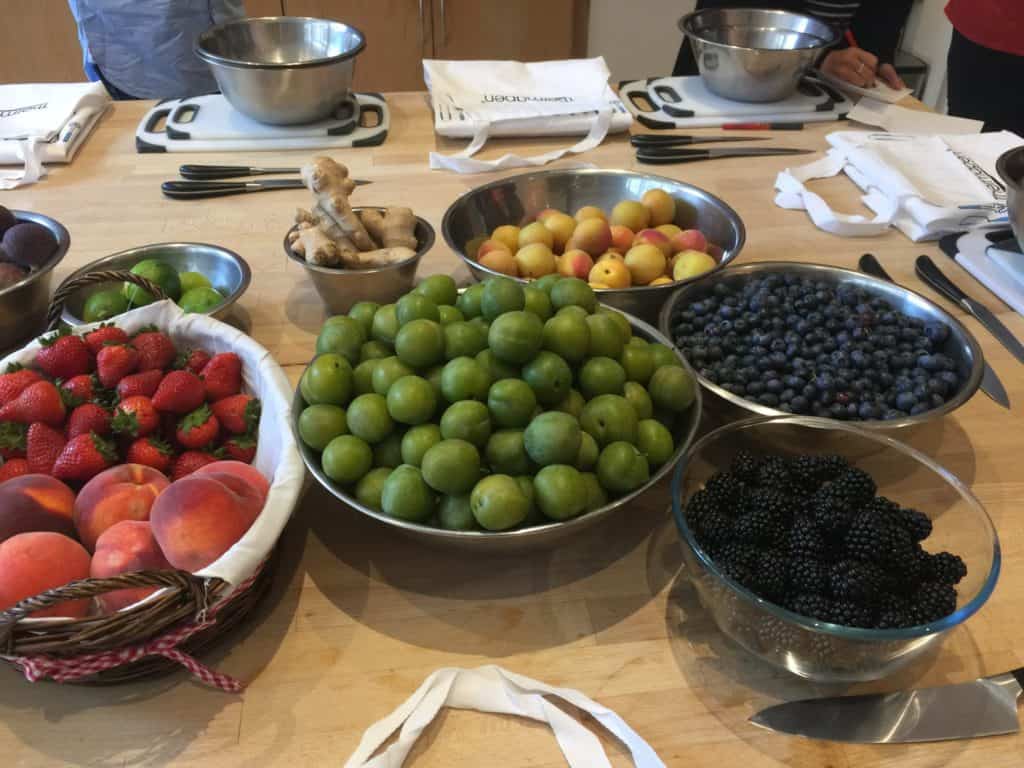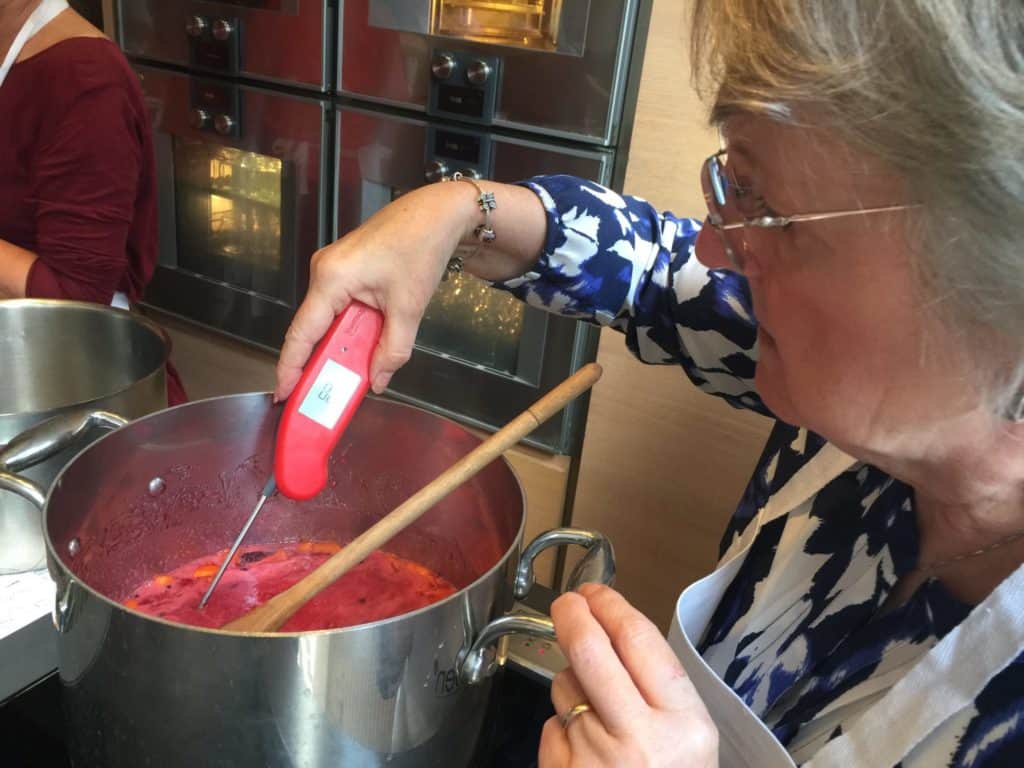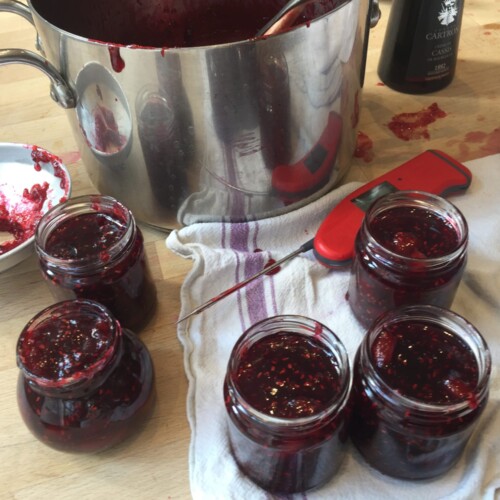This basic jam recipe can be adapted using different fruits and complementing flavours that you would get when adding Herbs, Spices or Liqueurs.

This traditional jam recipe makes about 3 large (approx 340g) or 5 small jars of jam and is given with kind permission by Mary Cadogen when I attended a Jam Workshop hosted by Thermapen and Mary Gadogan at La Cucina Caldesi Cookery School in London in Sept 2017.
Although this post was first written in Sept 2017 I have since updated it in July 2020 for easier reading.
A full list of ingredients and instructions can be found on the recipe card at the bottom of this post.

How to Create your own Signature Jam
Try making your own signature jam by experimenting with flavours. Here are a few suggestions to get you started. Whole spices and herbs need to be wrapped in muslin before adding to the fruit.
- Spices- cinnamon, star anise, ginger, fennel or mustard seeds, black pepper, cardamom, nutmeg herbs- bay, rosemary, basil, lemon verbena, mint, lavender
- Other flavourings such as lime, orange, vanilla pods, rosewater, orange flower water, licorice, earl grey or lady grey tea
- Liqueurs - Sweet wine such as Moscatel, crème de cassis or sherry, or liqueurs such as Cointreau or limoncello, or even a splash of gin, brandy or whiskey can be added after the jam has set, no more than 4 tablespoon per batch. You can add half with the fruit and the rest after the jam has set to really cook in the flavour.
Tips and Faq's for making Jam
- When to pick the fruit - Use fruit in season that is perfectly ripe or slightly under-ripe for the best results. Frozen fruit is also very good for making jam.
- High Pectin Fruit - Plums, damsons, blackcurrants, redcurrants, white currants, apples, rosehips
- Medium Pectin Fruit (use either sugar see note below) blackberries, apricots, blueberries, loganberries
- Low Pectin Fruit - peaches and nectarines, strawberries, rhubarb, cherries, passion fruit, figs

There are various ways of checking if your jam is set, the most reliable is using a digital thermometer as it takes the guesswork out of the process and ensures you don’t overcook the jam and preserve all the fruity flavours.
Another test is to put a saucer in the freezer when you start your jam making. When you think the jam has set, remove it from the heat and spoon a teaspoonful onto the chilled saucer. Leave a minute, then push the jam with your finger, if it wrinkles the jam is ready, if not return to the heat and boil for a further 5 mins before retesting.
Sugar/Preserving sugar is a large crystal sugar with no added pectin making it perfect for high - medium pectin fruits. See the list above.
Jam Sugar is a large crystal sugar with added pectin for use with lower pectin fruits. Both these sugars produce clearer results with less scum than granulated sugar, though they are more expensive.
Discover more tips for making the perfect jam and you will be well on your way to making jam more often.
Other Jam Recipes that you may like try.

Basic Jam Recipe
INGREDIENTS
- 1 kg Fruit See Tips and Faq's for s list of fruits
- Juice of 1 lemon
- 750 grams preserving sugar or jam sugar depending on the fruit. See Tips and Faq's for type of sugar to use.
- nob of butter
Instructions
- Wash the jars in hot soapy water and either put in a roasting tin and sterilise in the oven at 160C/fan 140C/gas 3 for 10 mins, or put upside down in the top of the dishwasher and run a hot wash without detergent. The jars need to be warm when filled so time this carefully. Put a saucer in the freezer. You will need this for checking if the jam is set.
- Prepare your fruit by chopping into evenly sized pieces. Put in a large heavy based pan with the lemon juice and sugar. Add flavourings of your choice tied up in a muslin bag if necessary. If you are adding liqueur this is stirred in at the end.
- Heat the fruit and sugar gently, stirring until the sugar has dissolved, then increase the heat and bring to the boil. Keep the jam at a good boil, stirring, until setting point of 105degrees C is reached on your digital thermometor. Or use the wrinkle test, see Tips and Faq's
- Skim off any excess scum from the surface of the jam using a slotted spoon, then stir in a knob of butter to remove any residue. Cool the jam for 10-15 mins, then stir to distribute the fruit evenly and ladle into the warm jars, using a jam funnel if you have one.
- Add wax discs to the surface of the jam and screw on the lids. When cool add the label with the type of jam and date made.
- Store your jam in a cool dry place.
Notes
HOW TO CREATE YOUR OWN SIGNATURE JAM
Make your own signature jam by experimenting with flavours. Here are a few suggestions to get you started. Whole spices and herbs need to be wrapped in muslin before adding to the fruit.- Spices– cinnamon, star anise, ginger, fennel or mustard seeds, black pepper, cardamom, nutmeg herbs- bay, rosemary, basil, lemon verbena, mint, lavender
- Other flavourings such as lime, orange, vanilla pods, rosewater, orange flower water, licorice, earl grey or lady grey tea
- Liqueurs – Sweet wine such as Moscatel, crème de cassis or sherry, or liqueurs such as Cointreau or limoncello, or even a splash of gin, brandy or whiskey can be added after the jam has set, no more than 4 tablespoon per batch. You can add half with the fruit and the rest after the jam has set to really cook in the flavour.
TIPS AND FAQ’S FOR MAKING JAM
- When to pick the fruit – Use fruit in season that is perfectly ripe or slightly under-ripe for the best results. Frozen fruit is also very good for making jam.
- High Pectin Fruit – Plums, damsons, blackcurrants, redcurrants, white currants, apples, rosehips
- Medium Pectin Fruit (use either sugar see note below) blackberries, apricots, blueberries, loganberries
- Low Pectin Fruit – peaches and nectarines, strawberries, rhubarb, cherries, passion fruit, figs


Comments
No Comments